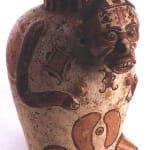Human Effigy Jar, 500 CE - 1000 CE
Terracotta
8.5 x 12
PF.4986
A vessel in the form of a human body, highly stylized, though realistic in many respects, constitutes a unique and fascinating genre. Within the mythical, almost supernatural context of this...
A vessel in the form of a human body, highly stylized, though realistic in many respects, constitutes a unique and fascinating genre. Within the mythical, almost supernatural context of this fabulous vessel, something very real is going on. The figure is in the seated position with short legs extended slightly to the sides; while the arms curve down from the upper portion to rest on the sides of the abdomen. These elongated arms have a distinctly animal appearance like the legs of a jaguar. The prominent head extends from the main body nearly reaching the top of the vessel's rim. The shape of the skull is monkey-like, though the intensity of the eyes and form of the mouth is distinctly human. Beautiful patterns on the forehead have a stenciled effect and are similar to the more elaborate ones on the upper corners of the chest. Two wide black areas divided by a bold red line and two white ones decorate a kind of tight fitting cap. Most intriguing is the painting of the kidneys surrounding the belly button. All these elements combine to form a type of iconography seen on other such vessels, and lead one to consider they were used for a specific purpose, such as containing medicines for the treatment of liver disease. The hunchback and pigeon breast, here represented as a general swelling of the back and abdomen, were physical marks of shamans who served the community as healers. Perhaps this vessel was owned by a shaman who wished to depict through tangible, visual representation, the power he possessed to cure disease.



